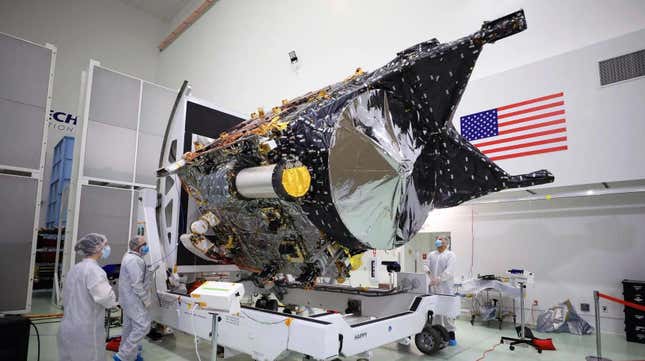
A gold-capped laser transceiver attached to the asteroid probe Psyche saw its first light on Tuesday, sending and receiving data through laser beams from far beyond the Moon for the first time.
NASA’s Deep Space Optical Communications (DSOC) experiment beamed data encoded within a near-infrared laser from nearly 10 million miles in deep space (16 million kilometers) to the Hale Telescope at Caltech’s Palomar Observatory in San Diego County, California, the space agency announced on Thursday.
Optical communication has been used to transmit data from Earth orbit and the Moon, but the recent test marks the farthest distance covered by the laser beams, as NASA seeks to fine tune its communication skills ahead of upcoming missions to deep space.
“Achieving first light is a tremendous achievement,” Abi Biswas, project technologist for DSOC at NASA’s Jet Propulsion Laboratory (JPL), said in a statement. “The ground systems successfully detected the deep space laser photons from DSOC’s flight transceiver aboard Psyche and we were also able to send some data, meaning we were able to exchange ‘bits of light’ from and to deep space.”
The DSOC transceiver launched on board the Psyche spacecraft on October 13 as the first demonstration of laser, or optical, communications from as far away as Mars. The primary purpose of the Psyche spacecraft is to explore and study the unique metallic asteroid Psyche, providing insights into the history of planet formation and core dynamics. Laser communication systems pack data into the oscillations of light waves in lasers, encoding a message into an optical signal that is carried to a receiver through infrared beams that the human eye can’t see.
NASA uses radio waves to communicate with its missions beyond the Moon but near-infrared light packs data into significantly tighter waves, which allows for more data to be sent and received. The DSOC experiment aims to demonstrate data transmission rates 10 to 100 times greater than current radio frequency systems used by spacecraft today, according to NASA.
Optical communications, however, becomes more challenging over longer distances as it requires extreme precision to point the laser beam. The farther away Psyche travels on its way to its asteroid target, the fainter the laser photon signal will become. Additionally, the photons will take longer to reach their destination, creating a lag of over 20 minutes. By the time the data reaches Earth, ground control will need to adjust for the new position of the spacecraft.
“Tuesday morning’s test was the first to fully incorporate the ground assets and flight transceiver, requiring the DSOC and Psyche operations teams to work in tandem,” Meera Srinivasan, operations lead for DSOC at JPL, said in a statement. “It was a formidable challenge, and we have a lot more work to do, but for a short time, we were able to transmit, receive, and decode some data.”
After achieving first light, the team will now work on refining the systems that control the pointing of the downlink laser aboard the transceiver. “Optical communication is a boon for scientists and researchers who always want more from their space missions, and will enable human exploration of deep space,” Jason Mitchell, director of the Advanced Communications and Navigation Technologies Division within NASA’s Space Communications and Navigation (SCaN) program, said in a statement. “More data means more discoveries.”
For more spaceflight in your life, follow us on X (formerly Twitter) and bookmark Gizmodo’s dedicated Spaceflight page.
https://ift.tt/xyoYezM
Science
No comments:
Post a Comment